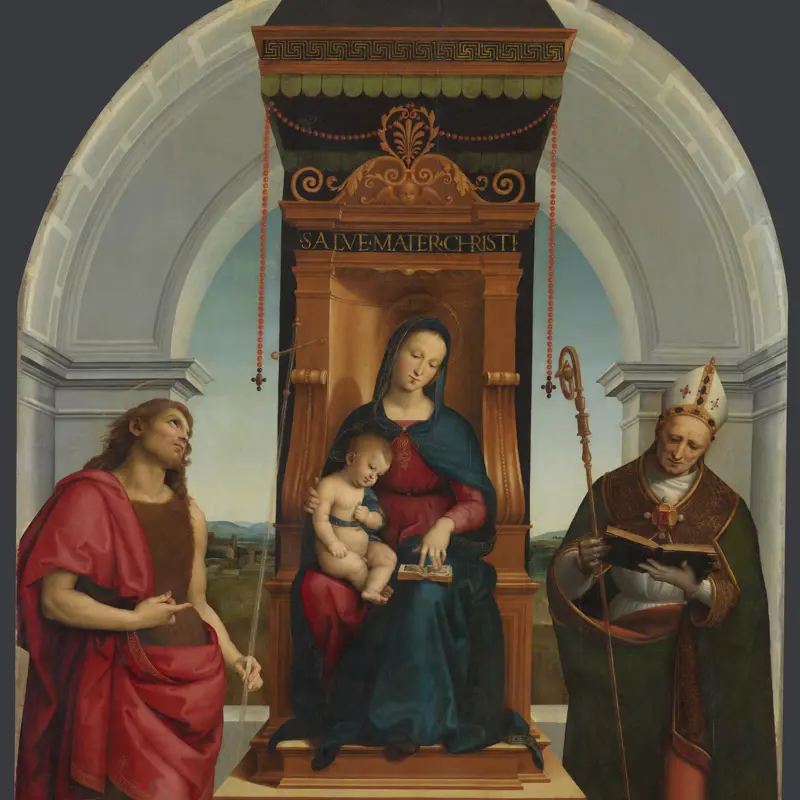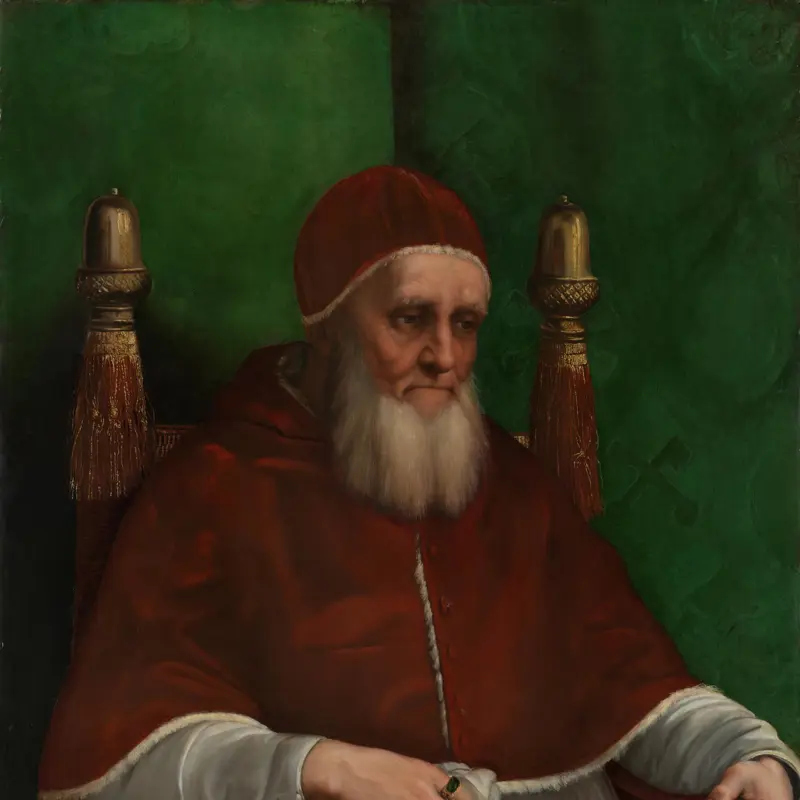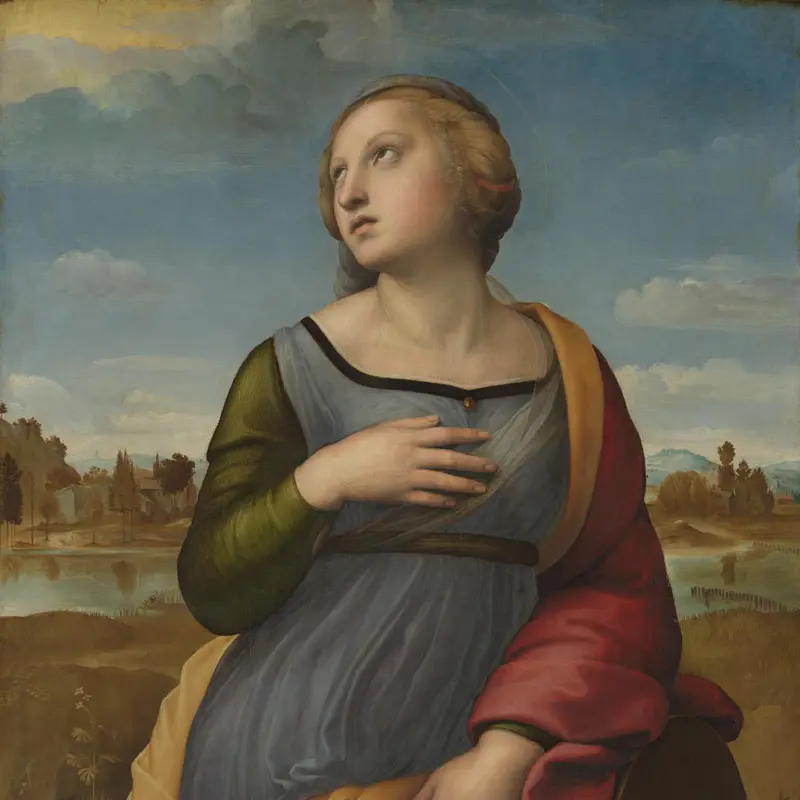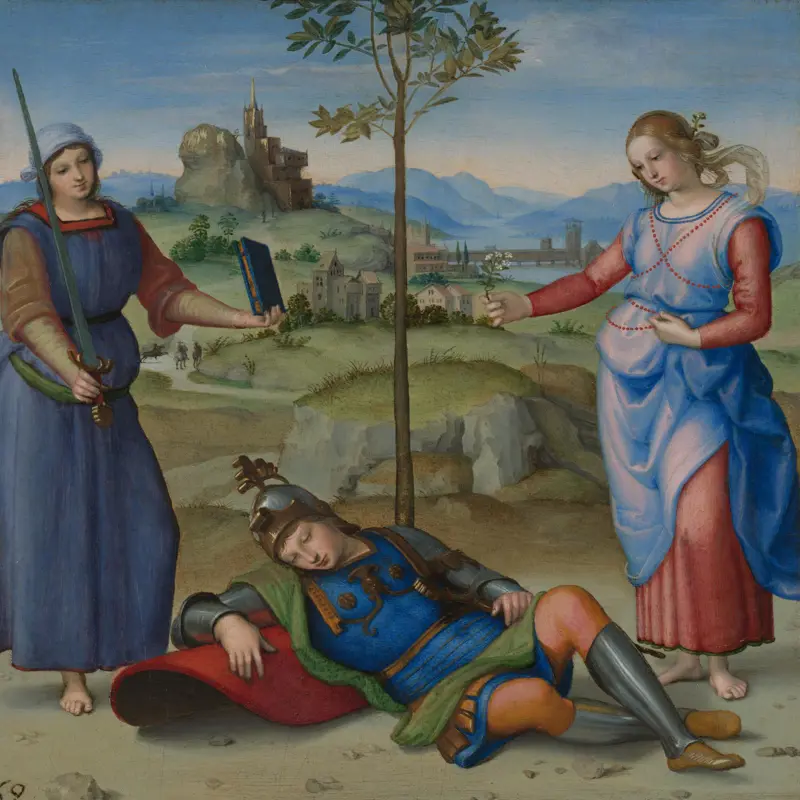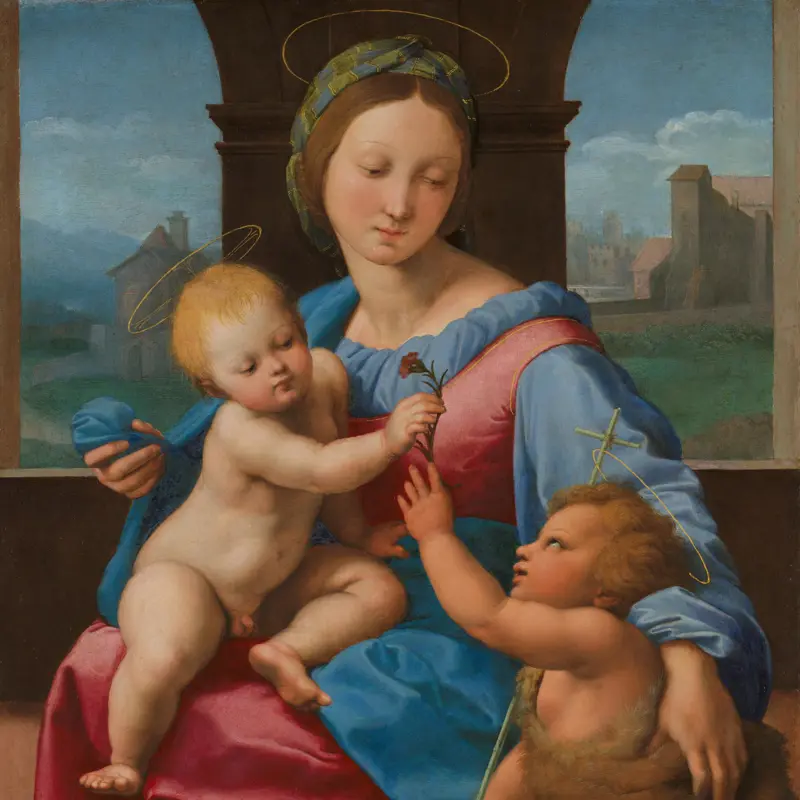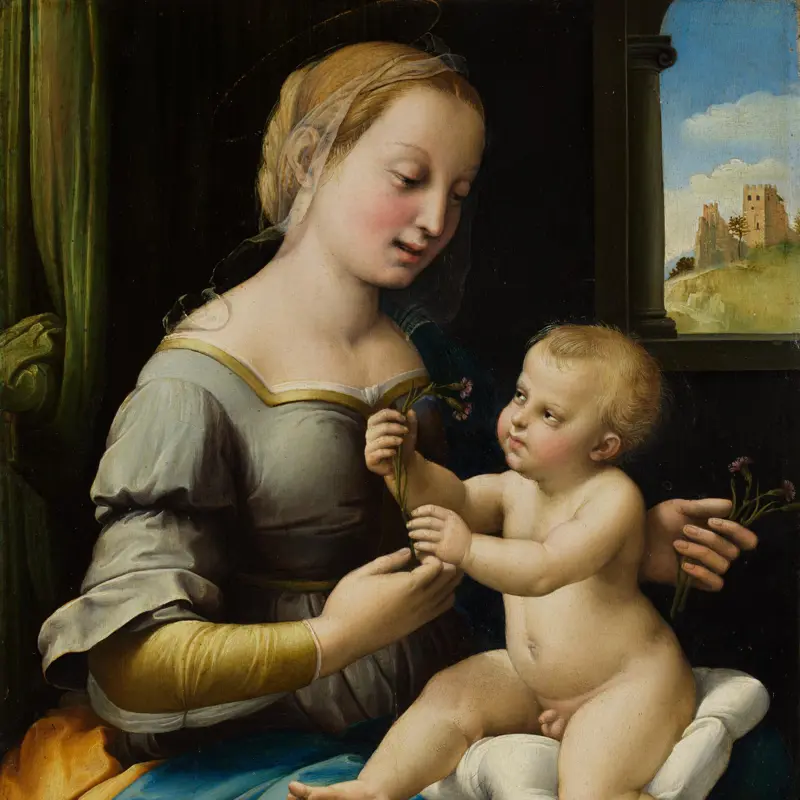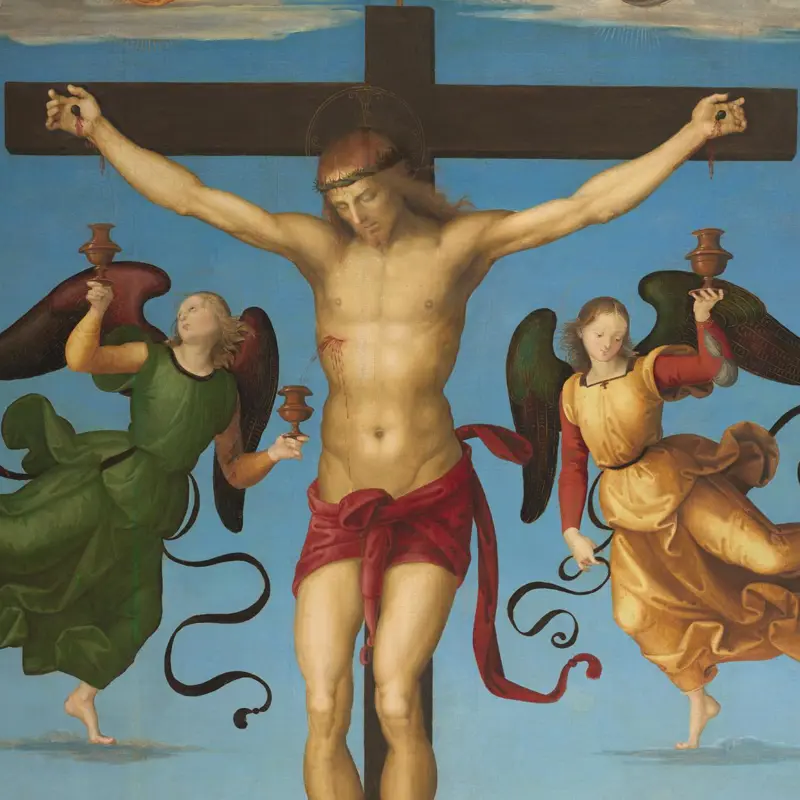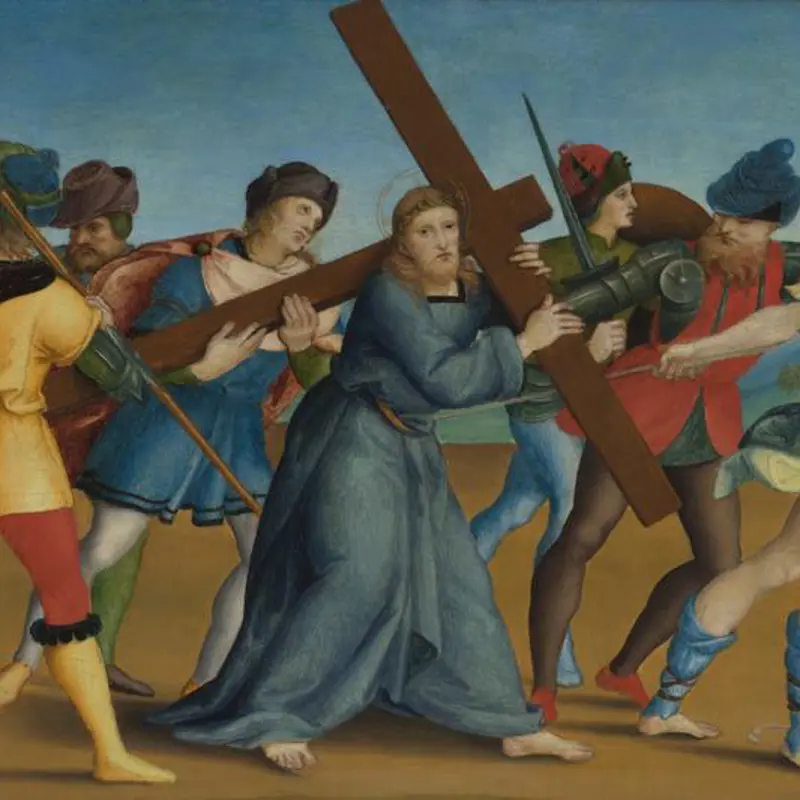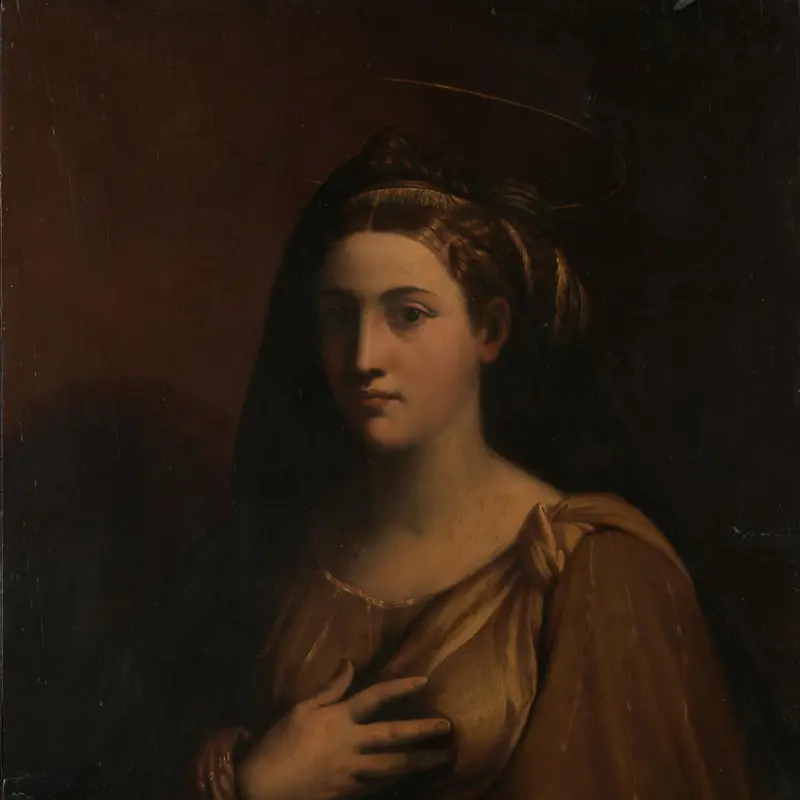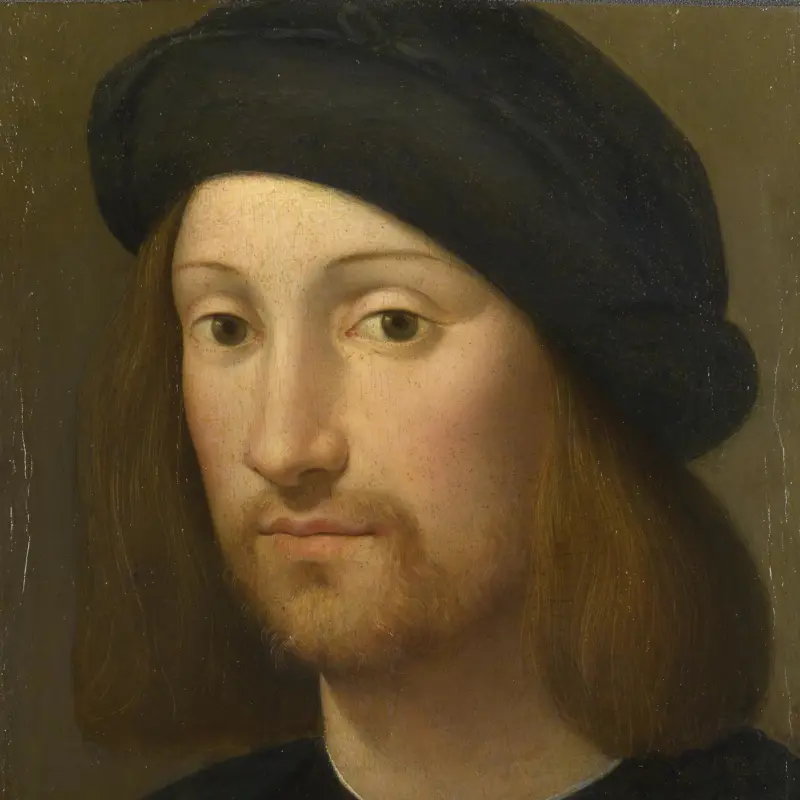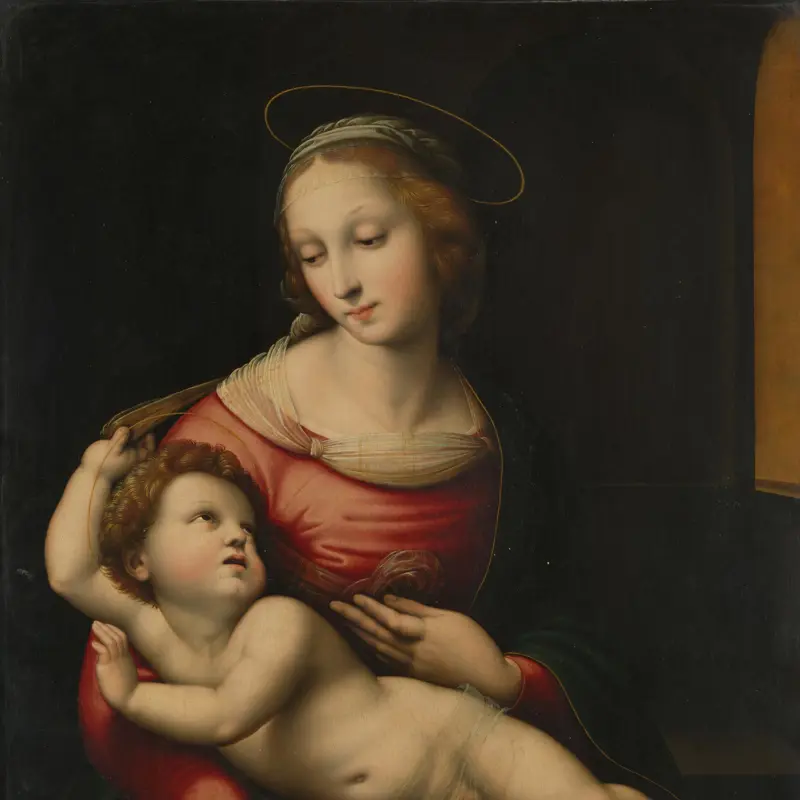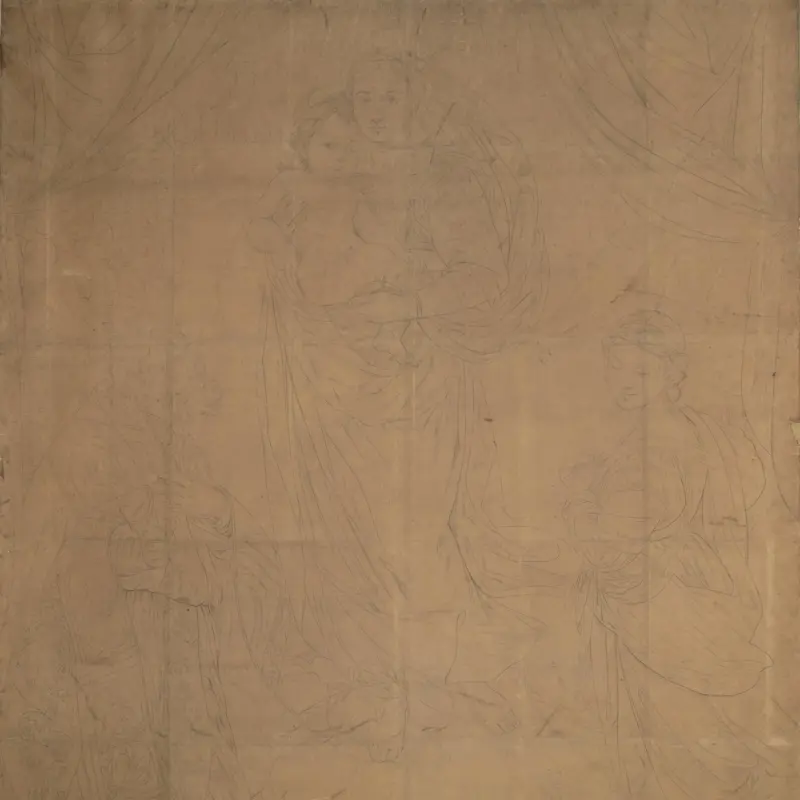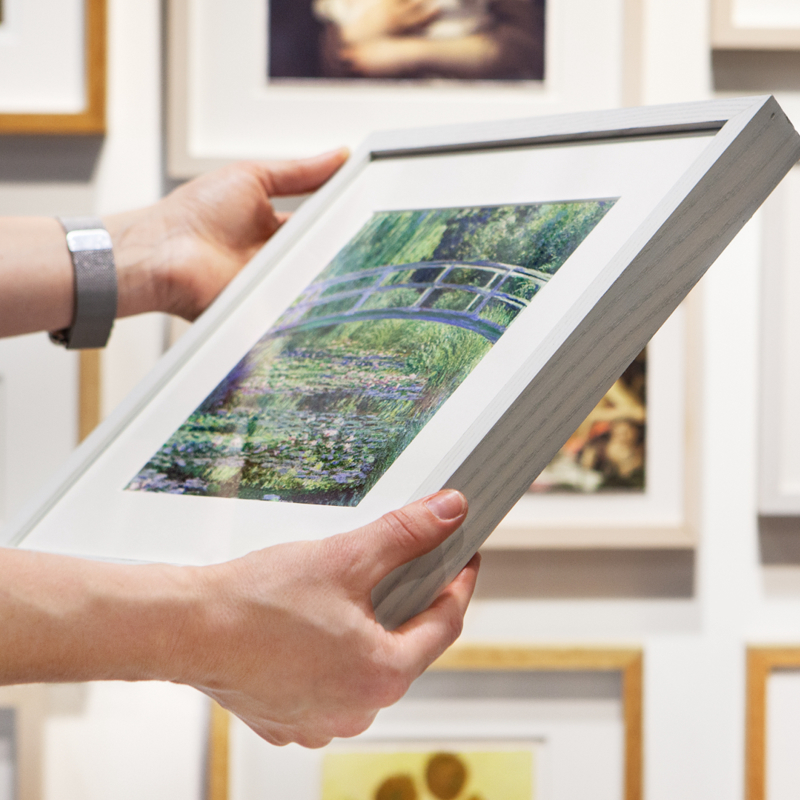Raphael, 'The Ansidei Madonna', 1505
About the work
Overview
This is the main panel of the altarpiece Raphael painted for the Ansidei family chapel in the Servite Church of S. Fiorenzo in Perugia in 1505.
The Virgin sits in majesty on a carved wooden throne with the Christ Child on her lap. She draws his attention to a passage in the book on her knee. A string of coral beads ending in jewelled crosses like a rosary is suspended from the throne, a reminder of the blood Christ will shed at the Crucifixion. The Latin inscription, ‘SALVE MATER CHRISTI’ (‘Hail Mother of Christ’), would have acted as a prompt to the recitation of the rosary. John the Baptist points to the infant Christ and gazes at his own cross, in foreknowledge of Christ’s future death. Saint Nicholas concentrates on his book.
Raphael carefully calculated the geometry of the composition, using an incised grid to divide it horizontally and vertically into harmonious thirds before he began painting.
Key facts
Details
- Full title
- The Madonna and Child with Saint John the Baptist and Saint Nicholas of Bari ('The Ansidei Madonna')
- Artist
- Raphael
- Artist dates
- 1483 - 1520
- Part of the series
- The Ansidei Altarpiece, San Fiorenzo, Perugia
- Date made
- 1505
- Medium and support
- Oil on wood (probably poplar)
- Dimensions
- 216.8 × 147.6 cm
- Inscription summary
- Dated
- Acquisition credit
- Bought, 1885
- Inventory number
- NG1171
- Location
- Room 61
- Collection
- Main Collection
- Frame
- 19th-century English Frame
Provenance
Additional information
Text extracted from the ‘Provenance’ section of the catalogue entry in Carol Plazzotta and Tom Henry, ‘National Gallery Catalogues: The Sixteenth Century Italian Paintings’, vol. 4, ‘Raphael’, London 2022; for further information, see the full catalogue entry.
Exhibition history
-
2022The Credit Suisse Exhibition: RaphaelThe National Gallery (London)9 April 2022 - 31 July 2022
Bibliography
-
1803W.F. Mavor, New Description of Blenheim, Oxford 1803
-
1836J.D. Passavant, Tour of a German Artist in England, London 1836
-
1854G.F. Waagen, Treasures of Art in Great Britain: Being and Account of the Chief Collections of Paintings, Drawings, Sculptures, Illuminated Mss. […], vol. 2, trans. E. Eastlake, London 1854
-
1860J.D. Passavant, Raphaël d'Urbin et son père Giovanni Santi, Paris 1860
-
1862G. Scharf, Catalogue Raisonné of the Pictures in Blenheim Palace, London 1862
-
1878G. Vasari, Le vite de'più eccellenti pittori, scultori ed architettori: Con nuove annotazioni e commenti di Gaetano Milanesi, ed. G. Milanesi, 8 vols, Florence 1878
-
1878A. Springer, Raphael und Michelangelo, Leipzig 1878
-
1882J.A. Crowe and G.B. Cavalcaselle, Raphael: His Life and Works, 2 vols, London 1882
-
1885London, National Gallery Archive, NG68/8/16: Papers Relating to the Proposed Purchase for the National Gallery of Certain of the Blenheim Palace Pictures: Presented to Both Houses of Parliament by Command of Her Majesty, 1885
-
1899L. Manzoni, 'La Madonna degli Ansidei', Bollettino della Regia Deputazione di Storia Patria per l'Umbria, 1899
-
1913O. Fischel, Raphaels Zeichnungen, Berlin 1913
-
1923A. Rosenberg, Raffael, des Meisters Gemälde, in 274 Abbildungen, ed. G. Gronau, Berlin 1923
-
1927L. Düssler, Signorelli, Klassiker der Kunst 34, Berlin 1927
-
1948O. Fischel, Raphael, trans. B. Rackham, London 1948
-
1957P.A. Riedl, 'Raffael's Madonna del Baldacchino', Mitteilungen des Kunsthistorischen Institutes in Florenz, VIII, 1957, pp. 223-46
-
1962Gould, Cecil, National Gallery Catalogues: The Sixteenth Century Italian Schools (excluding the Venetian), London 1962
-
1971L. Düssler, Raphael: A Critical Catalogue of His Pictures, Wall-Paintings and Tapestries, trans. S. Cruft, London 1971
-
1975C. Gould, Delaroche and Gautier: Gautier's Views on the 'Execution of Lady Jane Grey' and on other Compositions by Delaroche, London 1975
-
1977K. Oberhuber, 'The Colonna Altarpiece in the Metropolitan Museum and Problems of the Early Style of Raphael', Metropolitan Museum Journal, XII, 1977, pp. 55-91
-
1980L.S. Malke, Italienische Zeichnungen des 15. und 16. Jahrhunderts (exh. cat. Städelsches Kunstinstitut, 4 July - 31 August 1980), Frankfurt 1980
-
1981S.F. Pagden, 'An Early Drawing by Raphael: Original or Copy', Prospettiva, XXVII, 1981
-
1982K. Oberhuber, Raffaello, Milan 1982
-
1982P. de Vecchi, Tout l'oeuvre peint de Raphael, Paris 1982
-
1982D. Sutton, 'Aspects of British Collecting, II.VIII: From Rome to Naples', Apollo, CXVI/250, 1982, pp. 358-420
-
1983P. Joannides, The Drawings of Raphael: With a Complete Catalogue, Oxford 1983
-
1983R. Jones and N. Penny, Raphael, New Haven 1983
-
1983G. Dalli Regoli, 'Raffaello "angelica farfalla": Note sulla struttura e sulla fonti della pala Ansidei', Paragone, XXXIV, 1983, pp. 8-19
-
1983F.F. Mancini, 'Raffaello e Francesco Tifernate: Un documento e alcune precisazioni', Antichità viva, XXII, 1983, pp. 27-34
-
1984A. Braham and M. Wyld, 'Raphael's "S. John the Baptist Preaching"', National Gallery Technical Bulletin, VIII, 1984, pp. 15-23
-
1985G.B. Pezzini, S. Massari and S. Prosperi Valenti Rodinò, Raphael invenit: Stampe da Raffaello nelle collezioni dell'Istituto nazionale per la grafica catalogo, Rome 1985
-
1985L.D. Ettlinger, 'Raphael's Early Patrons', Studies in the History of Art, 1985
-
1986S.F. Pagden, 'The Early Raphael and His Umbrian Contemporaries', Studies in the History of Art, XVII, 1986, pp. 93-107
-
1987Gould, Cecil, National Gallery Catalogues: The Sixteenth Century Italian Schools, London 1987
-
1987F.F. Mancini, Raffaello in Umbria: Cronologia e committenza: Nuovi studi e documenti, Perugia: Volumnia 1987
-
1987Y. Kitaura, 'El Greco y Rafael', Goya, 1987
-
1990P. Hills, 'Ray, Line, Vision and Trace in Renaissance Art', Word and Image, VI, 1990, pp. 217-25
-
1990J. Plesters, 'Technical Aspects of some Paintings by Raphael in the National Gallery', in J. Shearman and M.B. Hall (eds), The Princeton Raphael Symposium: Science in the Service of Art History, Princeton 1990, pp. 15-37
-
1991J. Dunkerton et al., Giotto to Dürer: Early Renaissance Painting in the National Gallery, New Haven 1991
-
1992D. Cordellier and B. Py, Raphaël: Son atelier, ses copistes, Paris 1992
-
1994E. Langmuir, The National Gallery Companion Guide, London 1994
-
1994F. Russell, 'Early Italian Pictures and Some English Collectors (documents for the History of Collecting)', The Burlington Magazine, CXXXVI, 1994, pp. 85-90
-
1994L. Venturini, 'Il maestro del 1506: La tarda attività di Bastiano Mainardi', Studi di storia dell'arte, V-VI, 1994, pp. 132-83
-
1996J. Meyer zur Capellen, Raphael in Florence, trans. S.B. Polter, London 1996
-
1998S. Buck and P. Hohenstatt, Raffaello Santi, Known as Raphael, 1483-1520, Cologne 1998
-
1999R. Freiherr Hiller von Gaertringen, Raffaels Lernerfahrungen in der Werkstatt Peruginos: Kartonverwendung und Motivübernahme im Wandel, Munich 1999
-
1999K. Oberhuber, Raphael: The Paintings, Munich 1999
-
2000O. Garnett, 'The Letters and Collection of William Graham: Pre-Raphaelite Patron and Pre-Raphael Collector', The Walpole Society, LXII, 2000, pp. 145-343
-
2001
C. Baker and T. Henry, The National Gallery: Complete Illustrated Catalogue, London 2001
-
2001J. Meyer zur Capellen, Raphael: A Critical Catalogue of His Paintings, vol. 1, Beginnings in Umbria and Florence, ca. 1500-1508, Landshut 2001
-
2003J. Shearman, Raphael in Early Modern Sources (1483-1602), New Haven 2003
-
2003R. Goffen, 'Raphael's Designer Labels: From the Virgin Mary to La Fornarina', Artibus et historiae, XXIV, 2003, pp. 123-42
-
2003M. Spring, R. Grout and R. White, '"Black Earths": A Study of Unusual Black and Dark Grey Pigments used by Artists in the Sixteenth Century', National Gallery Technical Bulletin, XXIV, 2003, pp. 96-114
-
2004D. Cooper and C. Plazzotta, 'Raphael's Ansidei Altarpiece in the National Gallery', The Burlington Magazine, CXLVI, 2004, pp. 720-31
-
2004A. Roy, M. Spring and C. Plazzotta, 'Raphael's Early Work in the National Gallery: Paintings before Rome', National Gallery Technical Bulletin, XXV, 2004, pp. 4-35
-
2004H. Chapman, T. Henry and C. Plazzotta, Raphael: From Urbino to Rome (exh. cat. The National Gallery, 20 October 2004 - 16 January 2005), London 2004
-
2006T. Henry and F.F. Mancini, Gli esordi di Raffaello: Tra Urbino, Città di Castello e Perugia, (exh. cat. Pinacoteca Communale (Città di Castello), Palazzo Vitelli alla Cannoniera, 24 March - 11 June 2006), Città di Castello 2006
-
2006K.E. Butler, 'Riconsiderando il primo Raffaello', Accademia Raffaello. Atti e Studi, I, 2006, pp. 63-88
-
2007M. Spring, 'Raphael's Materials: Some New Discoveries and their Context within Early Sixteenth-Century Painting', in A. Roy and M. Spring (eds), Raphael's Painting Technique: Working Practices before Rome: Proceedings of the Eu-ARTECH Workshop, Florence 2007, pp. 77-86
-
2007R. Billinge, 'Recent Study of Raphael's Early Paintings in the National Gallery, London, with Infrared Reflectography', in A. Roy and M. Spring (eds), Raphael's Painting Technique: Working Practices before Rome: Proceedings of the Eu-ARTECH Workshop, Florence 2007, pp. 67-75
-
2008B. Cassidy, 'A Note on the Late History of Raphael's Ansidei Altarpiece', The Burlington Magazine, CL, 2008, pp. 672-5
-
2022Plazzotta, Carol, and Tom Henry, National Gallery Catalogues: The Sixteenth Century Italian Paintings, 4, Raphael, London 2022
Frame
This altar frame was crafted during the 1880s by Reginald Dolman and Sons, London. The company logo is stamped on the pinewood at the back of the predella.
The frame’s ornaments are made of pressed composition and are partially gilded with water and oil. The pilasters feature a classic design: acanthus leaves at the base lead to scrolling foliage, intertwined with birds, and a bird crowns the ornamentation against a gilded, punch-tooled background. The central Corinthian capitals are adorned with a bucranium (ox skull) and a serpent passing through its eye socket, symbolising the fleeting nature of life, rebirth and transformation.
The entablature frieze features intricate details including a repeat palmette and acanthus-leaf pattern on either side of scrolling flowers set on a dark blue background. The cornice includes classical motifs such as double bead-and-reel, lamb’s-tongue, egg-and-dart, and flutes on the corona, which is supported by leaf brackets. The arch-shaped slip has engraved decorations in the spandrels, while the inner edge is adorned with a leaf motif.
This replica altar frame is modelled on the portal ornaments of the Church of San Giobbe in Venice, carved by Pietro Lombardo (about 1435–1515).
The original frame had a deep rebate to conceal the unpainted parts of the panel and a wide strip of bare wood at the bottom to slot behind the predella for stabilisation.
When the National Gallery acquired Raphael’s ‘The Ansidei Madonna’, it was in a square, neoclassical French Empire-style frame with spandrels to create an arched shape. This frame is also seen in a photograph of it on display at Blenheim Palace around 1860. The frame rested on three rounded, bun-shaped feet positioned above an elegant mantelpiece. The painting, acquired with this frame, was displayed in the centre of the Gallery and draped with a curtain.
About this record
If you know more about this work or have spotted an error, please contact us. Please note that exhibition histories are listed from 2009 onwards. Bibliographies may not be complete; more comprehensive information is available in the National Gallery Library.
Images
About the series: The Ansidei Altarpiece, San Fiorenzo, Perugia

Overview
Raphael painted this altarpiece for the Ansidei family chapel dedicated to Saint Nicholas in the Servite Church of S. Fiorenzo in Perugia. The date MDV (1505) is inscribed in gold on the hem of the Virgin’s mantle.
The altarpiece would have consisted of the main panel, featuring the enthroned Virgin and Christ Child flanked by Saint Nicholas on the right and Saint John the Baptist on the left, and a lower horizontal set of painted panels collectively known as a predella. One of the two narrative scenes from the predella, Saint John the Baptist preaching, is also in the National Gallery’s collection. The other predella scene, which probably depicted a posthumous miracle of Saint Nicholas, is missing. Each narrative scene would have been positioned beneath the saint in the main panel to whom it related.

